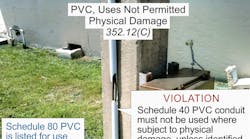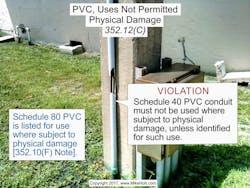Stumped by the Code? Uses permitted for PVC conduit by the NEC
All questions and answers are based on the 2017 NEC.
Q. What uses are permitted for PVC conduit by the NEC?
A. Some common uses for Type PVC (polyvinyl chloride) conduit are as follows:
Concealed — PVC conduit can be concealed within walls, floors, or ceilings, directly buried or embedded in concrete in buildings of any height [Sec. 352.10(A)].
Corrosive influences — PVC conduit is permitted in areas subject to severe corrosion for which the material is specifically approved by the authority having jurisdiction [Sec. 352.10(B)]. If subject to exposure to chemical solvents, vapors, splashing, or immersion, materials or coatings must either be inherently resistant to chemicals based upon their listing, or be identified for the specific chemical reagent [Sec. 300.6(C)(2)].
Wet locations — PVC conduit is permitted in wet locations such as dairies, laundries, canneries, car washes, and other areas frequently washed or in outdoor locations. Support fittings, such as straps, screws, and bolts, must be made of corrosion-resistant materials or must be protected with a corrosion-resistant coating, in accordance with Sec. 300.6(A) [Sec. 352.10(D)].
Dry and damp locations — PVC conduit is permitted in dry and damp locations, except where limited in Sec. 352.12 [Sec. 352.10(E)].
Exposed — PVC conduit is permitted to be used for exposed work. PVC conduit used in an area subject to physical damage must be identified for the application [Sec. 352.10(F)]. Schedule 40 PVC conduit is permitted for exposed locations where not subject to physical damage. Schedule 80 PVC conduit is identified for use in areas subject to physical damage.
Underground — PVC conduit installed underground must comply with the burial requirements of Sec. 300.5 [Sec. 352.10(G)].
Support of conduit bodies — PVC conduit can support nonmetallic conduit bodies that aren’t larger than the largest trade size of an entering raceway. These conduit bodies can’t support luminaires or other equipment and are not permitted to contain devices other than splicing devices permitted by Sec. 110.14(B) and Sec. 314.16(C)(2) [Sec. 352.10(H)].
Q. What uses are not permitted for PVC conduit by the NEC?
A. PVC conduit is not permitted to be used in the following locations:
Hazardous locations — PVC conduit isn’t permitted to be used in hazardous locations except as permitted by Sec. 501.10(A)(1)(a) Exception, Sec. 503.10(A), Sec. 504.20, Sec. 514.8 Exception No. 2, and Sec. 515.8. In Class I, Division 2 locations, except as permitted in Sec. 501.10(B)(7). [Sec. 352.12(A)].
Support of luminaires — PVC conduit isn’t permitted to be used for the support of luminaires or other equipment not described in Sec. 352.10(H) [Sec. 352.12(B)]. PVC conduit can support conduit bodies in accordance with Sec. 314.23(E) Exception.
Physical damage — PVC conduit isn’t permitted to be installed if subject to physical damage, unless identified for the application (see the Figure). Schedule 40 PVC conduit is not identified for use where subject to physical damage. PVC Schedule 80 conduit is identified for use in areas subject to physical damage [Sec. 352.10(F) Informational Note].
Ambient temperature — PVC conduit isn’t permitted to be installed if the ambient temperature exceeds 122°F [Sec. 352.12(D)].
Q. What are the minimum and maximum trade sizes allowed by the Code for PVC conduit?
A. Type PVC conduit smaller than trade size ½ isn’t permitted to be used. Type PVC conduit larger than trade size 6 isn’t permitted to be used. [Sec. 352.20].
These materials are provided to us by Mike Holt Enterprises of Leesburg, Fla. To view additional Code training materials offered by this company, visit www.mikeholt.com.





